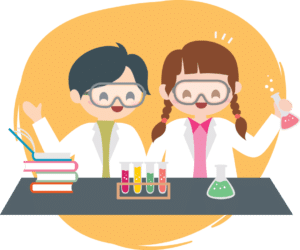Future Scientist, Future Engineer
Want to be an Engineer? A Scientist? Want to make a difference? Students at Colorado School of Mines study a wide range of subjects. From computer science to petroleum engineering, there is a fun and exciting future for you here.

Biomedical EngineeringBiomedical engineers are developing technologies that were once considered science fiction. From an exoskeleton that would help someone walk to a 3-D printer that could assemble an artificial kidney, biomedical researchers are using engineering principles to create new medical technologies. As the demand for biomedical technology increases, the Bureau of Labor Statistics projects that the biomedical engineering profession will grow much faster than other occupations through 2024.
Discovered in 1895, X-rays are electromagnetic energy waves that help doctors detect broken bones, dental problems and more.
Chemical EngineeringWhat’s your morning routine? Do you pack a plastic lunchbox, hop on a gas-powered school bus and set your textbook on your desk? Did you know that the lunchbox, fuel and textbook were developed by chemical engineers? Chemical engineers use chemical processes, such as fluid mechanics and thermodynamics, to convert materials into these items on a large, industrial scale.
Most industrial plastics are made from crude oil, which is distilled and combined with other ingredients to create material that can be molded into various shapes. ChemistryThe invention of various substances—from new medicines that make you feel better to the stuff that keeps your house clean to the flavor in your gum—required a knowledge of chemistry: the science that examines what things are made of, their properties and how they change under different conditions. Chemistry is often called the “central science,” because it bridges other physical sciences such as biology, geology and physics. How does soap make things clean?
Dirt is usually oil or grease, which does not mix with water. However, soap molecules have two different ends, one which is attracted to water and another which is not. That end attracts dirt, which allows it to be washed away. Civil EngineeringLook around your city—the bridges, buildings and roads that you use every day were designed and built by civil engineers. At Colorado School of Mines, civil engineering students have built steel bridges in national competitions, drawn blueprints for earthquake-resistant buildings and designed the infrastructure for bringing food, housing and clean water to communities around the world.
A truss bridge is supported by a series of triangles or trusses. Truss bridges have been built with stone, wood, iron and steel.
Computer ScienceFrom a cloud-based system that helps people avoid long supermarket lines to a wireless sensor system that helps sports commentators follow the game, computer scientists solve puzzles for almost every industry. They write code, make video games, create apps and program robots. By 2018, more than half of all STEM jobs are projected to be in computer science-related fields.
Machine learning is a type of artificial intelligence that allows computers to learn without having to be programmed to do so. IBM’s Watson, for example, can answer questions posed in the way humans normally speak. Economics and BusinessEconomics students at Colorado School of Mines study how the earth, energy and environment affect the economy and vice versa. With a strong background in business, math and science, alumni help shape public policy and industry trends. Faculty and students have studied how environmental policy affects the market, how currency depreciation influences oil prices and how the international economy responds to global climate change.
Cap-and-trade programs are government programs that place caps on the amount of greenhouse gas pollution a company can produce. Businesses receive emissions permits, which they can spend or transfer to other companies. Electrical EngineeringElectrical engineers design, test and develop systems and devices that involve electricity, electronics and electromagnetism. This means they have a hand in everything from the minuscule microchips in your phone and computer, to the appliances in your kitchen, to the continent-spanning power grids that keep all these things running.
A magnetron, or electron tube, produces radio waves that are absorbed by molecules of water, heating them and cooking the food. |
Engineering PhysicsPhysicists study how matter and energy interact, helping us to learn more about the structure of the universe and the nature of time. Engineering physics combines a deep understanding of the fundamentals of traditional physics with the practical knowledge and skills of engineering practice and design. At Mines, students and faculty helped assemble a space observatory that launches from New Zealand in March 2017. Physicists have also developed technologies such as lasers for eye surgery, radiation detectors and microscopes.
Sir Isaac Newton, an English physicist and mathematician, published the universal law of gravity in the late 1600s. It says that the gravitational force between any two objects is proportional to the product of their masses and inversely proportional to the square of the distance between them. Environmental EngineeringEnvironmental engineers are dedicated to protecting the environment and providing clean water, air, energy and natural resources. They develop physical and mathematical models of environmental systems finding solutions for reducing pollution, cleaning up soil, treating groundwater and recycling wastewater. Environmental engineering students at Colorado School of Mines solve real-world environmental engineering problems on Colorado’s Front Range.
Nonpotable water is not suitable for drinking. Derived from recycled water or rainwater, nonpotable water can be reused for non-drinking Geological EngineeringGeological engineers are the bridge between the Earth’s resources and engineering. They locate new water, energy and rock and mineral resources, and minimize safety hazards by identifying locations that provide stable foundations for buildings and other facilities.
Minerals are naturally occurring, inorganic solids that contain no carbon. Minerals are usually extracted from the earth by mining or drilling. Examples include oil, natural gas, gold and silver. GeophysicsGeophysicists look beneath the surface of the earth to find sources of water and energy, as well as monitor risks associated with earthquakes, volcanoes and climate change. Geophysics draws from several disciplines, including geology, mathematics, physics and computer sciences. What is geothermal energy?
Geothermal energy is the heat beneath the surface of the earth, which scientists are converting into renewable electricity, heating and air conditioning. Math and StatisticsMathematicians create mathematical models and statisticians analyze data to help us forecast things like wind speed, graph disease outbreaks and answer questions about metabolic reactions. Because of increased use of digital data, the Bureau of Labor Statistics predicts that employment of mathematicians and statisticians will grow much faster than average through 2024.
Pi (Greek letter “π”) is the ratio of a circle’s circumference to its diameter. It is equal to approximately 3.14159. The Math Club at Colorado School of Mines has celebrated Pi Day on March 14 (3-14) with pizza, pie and math bingo. Mechanical EngineeringMechanical engineers design, build and optimize products such as clean combustion engines, space-exploring robots and power plant technology that converts solar thermal energy into electrical energy. For their senior year, mechanical engineering students at Colorado School of Mines solve real design challenges for clients such as the U.S. Olympic Committee, Shell and the National Renewable Energy Laboratory.
Bullet trains travel along tracks that use magnetic force to both suspend cars and move them forward. This greatly reduces friction and allows for very high speeds. Trains using magnetic levitation also move more smoothly and quietly than traditional trains. Metallurgical and Materials EngineeringMetallurgical and materials engineers transform raw materials into products such as aircraft wings, golf clubs, and shatterproof glass for smartphones and even create new materials with never-before-seen properties. They process and test materials using supercomputers, metal foundries, welding labs and more.
Semiconductors are solids, such as silicon or germanium, whose electrical conductivity at room temperature is between that of a conductor (such as metal) and an insulator (such as plastic). Computers, the internet and automobiles use semiconductor technology.
Mining EngineeringMining engineers recover and process natural resources, design underground tunnels and develop mining safety procedures. Ranked the number one mining school by QS World University Rankings in 2016, Colorado School of Mines offers labs in its own Edgar Experimental Mine, which produced silver, gold, lead and copper in the 1870s. What is the chemical symbol for gold?
The chemical symbol for gold is “Au,” which originates from the Latin word for gold, “Aurum.” Petroleum EngineeringPetroleum engineers help to safely meet the world’s demand for energy. They design methods to extract oil and gas from the Earth, analyze reservoirs and rock properties, and contribute to the development of alternative energy sources, such as wind power and thermal energy.
Crude oil is a liquid mixture of hydrocarbons from the earth. It is then refined to produce products such as petroleum gasoline, asphalt, diesel and most plastics. |
 What are X-rays?
What are X-rays?

